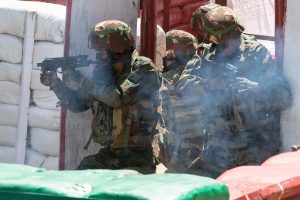As the India-China military crisis in eastern Ladakh enters its fourth month, there are scant signs that a peaceful solution is in the offing any time soon. On Monday morning, the Indian government issued a statement which noted that the army had pre-empted a Chinese push into the southern bank of the Pangong Lake, suggesting a new area of dispute had been created. (Up until the Indian statement, it was believed that the northern bank of the lake along with a few other points in eastern Ladakh where the only flashpoints.)
Soon after this, the Chinese government in a barrage of statements accused India of attempting to change the status quo in eastern Ladakh at two points through a military push. Over the past few days, both governments have provided little clarity on what, in fact, is going on and have focused on generalities of the situation instead. Absent the opportunity for ground reporting, most journalists covering the developments have relied on anonymous government sources.
But sifting through media reports, two interrelated things have become clear, each of which has tremendous import for the future of the India-China crisis and the relationship in general. One, after months of prevarication, India’s military posture in eastern Ladakh is now extremely robust. Two, New Delhi is willing to deploy sharp tools to settle the dispute on its own terms, or at least force China to negotiate in good faith.
Beyond the lack of on-the-ground reports and a forbidding and unfamiliar terrain, what further makes the current crisis almost impossible to objectively track in terms of establishing chains of unfolding events is the fact that the 3,488-kilometer long India-China boundary remains largely undefined, neither marked on paper nor demarcated on land. In Ladakh, and the western sector of the Line of Actual Control (LAC) in general, China and India have yet to exchange maps which would establish each other’s claims.
Instead, the LAC that separates India and China is a phantom object, unlike the India-Pakistan Line of Control (LOC) which is marked on mutually accepted maps though not an international border by any means. In so far as the LAC exists it is through tacit understanding based on past patterns of patrolling by the Indian and Chinese armies. So, news reports that suggest India had crossed the LAC around the weekend – or that China had done so – to capture key peaks in the southern bank of the Pangong Lake should be taken with an appropriate degree of caution.
However, going by the relentless and strident Chinese statements – not to mention belligerent op-eds in the state-run Global Times – India did, over the past weekend and early this week, take military steps that have upset China. It does seem likely that India has managed to occupy one or more peaks on the southern bank of Pangong Lake. Capturing heights from China’s control not only gives the Indian Army ability to surveil territory occupied by the Chinese in the vicinity (useful in the event India does decide to evict the People’s Liberation Army by force) but also — as many have pointed out — serve as a bargaining chip to restore status quo ante through exchange of territory in each other’s control exceeding customary claims.
Either way, Indian actions early this week mark a turning point in the ongoing crisis.
Most strikingly credible news reports that India used the highly-secretive Special Frontier Force (SFF) to launch measures it did has been the highlight of the week. The paramilitary SFF reports to the chief of the Research & Analysis Wing, India’s external spy service, and at least one (“Vikas”) battalion of the SFF is manned by ethnic Tibetans in India. The SFF functions like the Special Activities Division of the U.S. Central Intelligence Agency (CIA). The force grew out of “Establishment 22,” a Tibetan guerrilla force that was trained jointly by the CIA and India after the 1962 India-China War.
The message India sought to send China by using ethnic Tibetans in a military operation against that country is self-evident. How Beijing reacts to this in the future – by resuming full-throated support for insurgents in India’s Northeast, for example – remains to be seen.
What does the road ahead for the crisis in Ladakh look like? The Diplomat spoke to Praveen Swami, an Indian journalist well known for his coverage of sensitive defense and intelligence matters, on how he saw the situation evolving. Swami suggested two scenarios: one (the “good”) is where India relinquishes the peak it has supposedly occupied in the southern bank of Pangong Lake in return for China giving up its claims between Fingers 4 and 8 on the northern bank. According to him, the other (“bad”) scenario is where “both sides will be jumping to occupy hill features, of which there are literally hundreds to be grabbed.” He reminded The Diplomat that such peak grabbing was the norm between the India-Pakistan LOC in the 1990s.
In early 1999 Pakistan launched a particularly large-scale operation to seize Indian heights in the Kargil-Dras sector – which now is designated as part of western Ladakh, following India-administered Kashmir’s reorganization in August last year — leading to one of the two instances where two nuclear-armed states (India and Pakistan) have gone to war.

































